Fueling the Future
Koloma explores hydrogen’s potential in a new OSU lab.
How AI is impacting recruiting and hiring
Sonya Thesing’s new role at the Hous Foundation
14


Koloma explores hydrogen’s potential in a new OSU lab.
How AI is impacting recruiting and hiring
Sonya Thesing’s new role at the Hous Foundation
14

Derrick Clay’s mission to move the Columbus Chamber of Commerce forward






On Oct. 8, Columbus CEO celebrated the 18th annual Best of Business awards at Vitria on the Square. The event honored the 82 local businesses and organizations that Columbus CEO readers deem the best of the best.
THANK YOU TO OUR SPONSORS

PRESENTING SPONSORS

PLATINUM SPONSORS

GOLD SPONSOR

SUPPORTING SPONSORS






Columbus Monthly’s Cocktail Competition brings together the city’s top bartenders and standout bar programs for an unforgettable evening.
Guests will sip inventive cocktails crafted with Noble Cut Distillery spirits, enjoy live music and entertainment, and experience the creativity of Central Ohio’s favorite bars. Bartenders will compete in three categories—Most Creative, Best Booth Design, and Best Overall—and attendees will help decide the winners with their votes.
Nov. 6, 2025 | 5:30-7:30 PM Vitria on the Square Tickets are $45
Liquor Sponsor:

Venue Sponsor:

TICKETS:














Give your child the world.






605 S. Front St., Suite 300
Columbus, Ohio 43215
Phone: 614-540-8900
ColumbusCEO.com
VOLUME 34 / NUMBER 6
GENERAL MANAGER
DISPATCH MAGAZINES
Katy Smith
EDITORIAL
EDITOR
Julanne Hohbach
CONTRIBUTING EDITORS
Linda Lee Baird, Lucy Clark
CONTRIBUTORS
Tim Feran, Cynthia Bent Findlay,
Nichole Frederick, Laura Newpoff, Chuck Nelson, Peter Tonguette
DESIGN & PRODUCTION
PAGE DESIGNERS
Kaity Athialy, Kathryn Biek, Kelly Hignite, Hannah Patton
PHOTOGRAPHY
PHOTO EDITOR
Tim Johnson
ADVERTISING MULTIMEDIA SALES MANAGERS
Heather Kritter, Adam Trabitz
PRODUCTION DESIGNER
Rebecca Zimmer
MARKETING MARKETING MANAGER
Lauren Reinhard
PRESS RELEASES pressreleases@columbusceo.com
ADVERTISING advertise@columbusceo.com
Columbus CEO (ISSN 1085-911X) is published six times a year by Gannett. All contents of this magazine are copyrighted © Gannett Co., Inc. 2025, all rights reserved. Reproduction or use, without written permission, of editorial or graphic content in any manner is prohibited. Publisher assumes no responsibility for return of unsolicited materials. Known address of publication is 605 S. Front St., Suite 300, Columbus, Ohio 43215. Periodicals postage paid at Columbus, Ohio, and additional mailing offices. POSTMASTER: Send address changes to Columbus CEO, P.O. Box 460160, Escondido, CA 92046
SUBSCRIPTIONS
760-237-8505
columbusceo@pcspublink.com
* jhohbach@ColumbusCEO.com
Running a business is no small feat. Whether it’s a mom-and-pop bakery or a larger enterprise, launching a new company isn’t as easy as just hanging out a sign or launching a website. There’s ever-present pressure to find customers, pay invoices, fulfill orders, stay current on legal issues and countless other tasks.
In light of those challenges— not to mention the long hours and personal sacrifice that many owners invest—it’s unfortunate, but perhaps not surprising, that the long-term success rate of entrepreneurship is relatively modest.
According to data from the U.S. Bureau of Labor Statistics, just 34.7 percent of privatesector businesses launched in March 2013 were still operating 10 years later.
The saying that “revenue causes and solves all problems” may oversimplify the operational complexities, but tell that to the small business owner who anxiously goes through the mail each day hoping an outstanding check arrived so they can make payroll.
That’s an experience that’s all too familiar to Derrick Clay, the new president and CEO of the Columbus Chamber of Commerce. Clay, a former chamber board member, has been leading the organization since January.
Clay brings to the table a wide-ranging skill set that encompasses stints hawking
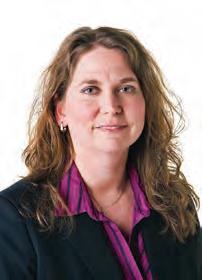
copiers, owning and selling a business, and working in politics as both a lobbyist and a campaign manager—including for the 2000 Gore-Lieberman presidential campaign.
These days, Clay admits to being “very partisan, but I’m partisan for the business community.” He’s bullish on business and the chamber and already has launched a new set of initiatives to support its members.
In September, Clay presided over his first Clambake & Lobster Feast, the chamber’s signature annual fundraiser. As Clay mingled with guests, indulged requests for photos and emceed the event, it wasn’t hard to see that he might be—in the words of one former Columbus mayor— the right person at the right time in this new role.
Freelance writer Tim Feran caught up with Clay at the chamber’s Downtown offices to learn how the Toledo native leveraged a background in politics and lobbying into a passion for the business community. Learn more in “Right Person, Right Time,” starting on Page 8.
Thanks for reading.

Julanne Hohbach Editor
While researchers work to improve lobular breast cancer screening, innovative treatments are improving outcomes for patients with the condition, which is diagnosed in more than 40,000 Americans each year.
Lobular breast cancer — or invasive lobular carcinoma (ILC) — is a form of breast cancer that starts in patients’ lobules, or milk-producing glands. ILC may not be a common term among the larger public, but it makes up approximately 10 to 15 percent of all breast cancers diagnosed in the U.S.
“There are different types of breast cancer — invasive ductal carcinoma, the most common type, which begins in the ducts that carry milk to the nipple, and invasive lobular carcinoma, which starts in the lobules that produce milk,” says Arya Roy, MD, a medical oncologist at The Ohio State University Comprehensive Cancer Center – James Cancer Hospital and Solove Research Institute (OSUCCC – James).
While ILC is usually cured when caught early, a lack of widely-known symptoms, along with screening challenges and higher rates of late recurrence, make it vital that researchers continue their efforts to improve diagnostic techniques and technologies.
“We can give hope to ILC patients by developing more tools to identify the cancer as much as possible so that we can make sure it’s completely cured,” Roy says.
Scan the QR code to learn more about breast cancer, including risks, symptoms and treatment at the OSUCCC – James.
Invasive lobular carcinoma diagnosis challenges
Unlike some other types of breast cancer that form in masses, ILC cells tend to grow in single-file lines.
“Usually when people think about breast cancer, they think about lumps, but in most lobular breast cancer cases, there won’t be one,” Roy says. “ILC does not have a protein (called E-cadherin) in the cells
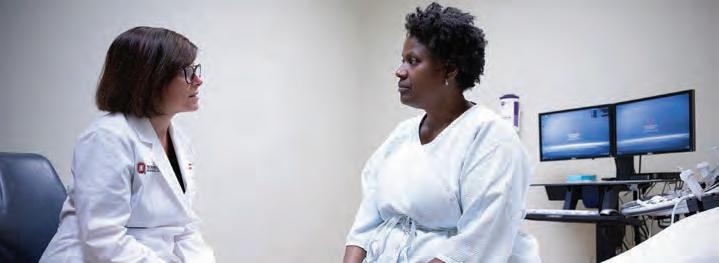
which makes them stick together, so the cancer actually forms in lines or chains.”
While lumps usually aren’t present with ILC, there are some potential symptoms, including:
• Swelling of the breast
• Thickening of breast skin
• Changes in the nipple, including inversion
When ILC is diagnosed, doctors use MRI and other tests to determine size and stage so that unique treatment plans can be created for each patient.
“ILC is almost always estrogen receptor–positive, so we use an FES PET scan to identify the spread of the cancer,” Roy says. “This newer imaging technology helps detect cancers that have high levels of estrogen receptor expression.”
While doctors and researchers are working to improve ILC screening, identifying possible risk factors could raise the chances of early diagnosis, including:
• Family history of ILC or stomach cancer
• LCIS lesion in the breast
• CDH1 genetic mutation
• Dense breasts
Scan the QR code to learn more about cancer screening and diagnosis at the OSUCCC – James.
Lobular breast cancer treatment and research
ILC tumors tend to grow more slowly than other breast cancers, which can raise the chances of successful treatment.
Doctors sometimes administer chemotherapy before surgery to try to reduce the size of ILC tumors before removal, but the presence of estrogen can reduce its effectiveness.
“ILC usually does not respond to chemotherapy very well because the cancer is highly hormone positive,” Roy says.
However, patients with estrogen-positive ILC may benefit from endocrine therapy administered before surgery. Multiple clinical trials are currently underway at Ohio State involving this treatment, which directly targets estrogen to shrink tumors or stop their growth. While therapy and surgery often lead to successful initial treatment of lobular breast tumors, ILC patients can be at higher risk of recurrence than invasive ductal survivors.
“We don’t currently have a specific tool to identify lobular breast cancer recurrence risk,” Roy says. “We are using techniques for invasive ductal breast cancer, but that’s not always accurate.”
Roy and her colleagues are working to fill that gap through clinical research that uses artificial intelligence to improve ILC recurrence risk assessment.
“We’re developing an AI model that analyzes higher risk features obtained from digital pathology images of removed tumors, and combining those with the patients’ clinical features,” Roy says. “Then, an algorithm will help us predict the patients with a higher risk of ILC recurrence.”
Roy’s team is currently using patient information to train the AI model with the goal of developing a scoring system that identifies patients at high risk for recurrence. The training process is lengthy, but the benefits could be well worth the effort.
“We can keep the patients in long-term surveillance to diagnose recurrences early, when the cancers are at their most treatable stages,” she says.
Scan the QR code to learn more about lobular breast cancer care at the OSUCCC – James.
BY TIM FERAN
Derrick Clay brings decades as a lobbyist, working with some of the most influential people in Ohio, to a new role leading the Columbus Chamber of Commerce.
It’s been said that crisis doesn’t build character, crisis reveals character—especially among leaders.
During multiple times in his life, Derrick Clay has faced crises, both big and small, and they have revealed exactly what kind of leader he is—and why he was chosen to become president and CEO of the Columbus Chamber of Commerce in January 2025.
“If you were going to go in a laboratory and build someone perfectly suited to be the CEO of the Columbus Chamber, you would get Derrick,” says Steve Stivers, president and CEO of the Ohio Chamber of Commerce. “He’s super engaged, he’s been on so many boards. He knows everyone in the business community.”
Clay’s journey began in Toledo, where his father was a factory worker for multiple companies, including Jeep. His mother was a schoolteacher who taught first grade for 30 years.
“Oh, man, people all the time

would come up to me and say, ‘Is your mom Mrs. Clay?’” because they had been in her class, and because “she was a wonderful schoolteacher,” Clay says, chuckling. “I grew up on public education in Toledo public schools.”
That public education included Macomber-Whitney High School, a vocational high school. “We had different trades that we could take on,” he says. “I took on data processing.”
Heading to college at the University of Akron, he majored in business and organizational communication, “really studying how business and communication intersect.”
He also was very involved in student activities. “I was on the student government and ended up being
president of Associated Student Government my senior year.”
But the year before Clay was to graduate, his father died.
“My mom was in Toledo by herself, and I was like, well, maybe I go home and help mom for a couple years and figure out what I’m doing. And that was going to be my plan.”
Clay decided he was “going to work at a radio station, and they had worked out a little deal for me that I could sell advertising during the day, and I could DJ at night, and so that’s what I was going to do, right?
“But God had a different plan for me.”
One of Clay’s fraternity brothers was working for Vernon Sykes, who at the time was the assistant
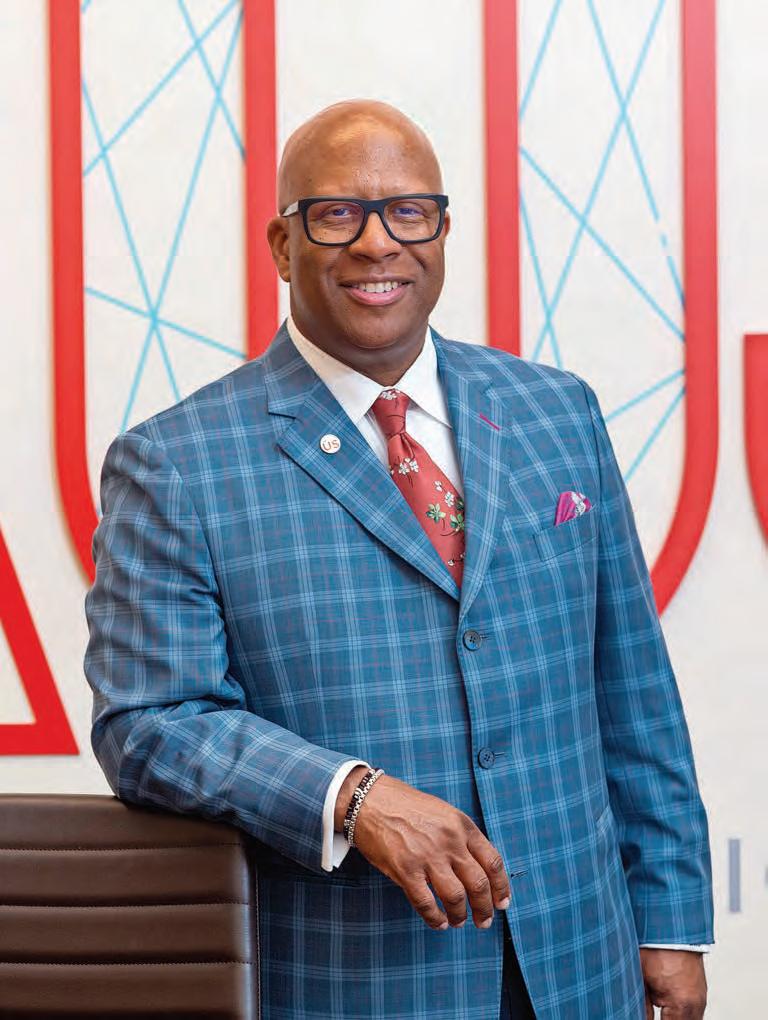
majority floor leader in the Ohio House of Representatives. “My fraternity brother had just gotten a new job, and Representative Sykes asked him who would be a potential good replacement for him. He recommended me.”
Two weeks later, Clay had left all thoughts of working at a radio station far behind. “I was fortunate enough to get the job. So I worked in his office as his senior aide.”
Clay went on to work in other political positions, including as executive director of the Ohio Legislative Black Caucus, working with 18 African American legislators in the Ohio General Assembly.
“And then I got a big break: I was tapped to run Al Gore’s presidential
campaign [in Ohio] in 2000. I worked on the Gore-Lieberman campaign, and my work took me to Florida for a month and a half with the Florida recount, and the hanging chads, all that stuff.”
A job as Midwest political director with the Democratic Congressional Campaign Committee came next, “and basically I helped run campaigns throughout the Midwest for various different candidates.”
At that point, Clay admits, “I got totally burnt out of politics, and went and sold copiers for a year.”
What could have been a year of drudgery turned out to be “a great experience, because I learned a lot about people, and I learned how to be nimble on your feet and be told ‘No’
CEO
Columbus Chamber of Commerce
Age: 54
Previous: Senior vice president, Shumaker Advisors; owner and principal, New Visions Group; Midwest political director, Democratic Congressional Campaign Committee; Ohio director, Gore-Lieberman 2000 presidential campaign; executive director, Ohio Legislative Black Caucus
Education: Bachelor’s degree in business and organizational communication, University of Akron
Involvement: Board member, the Athletic Club of Columbus, Columbus Symphony Orchestra, Mid-Ohio Regional Planning Commission, Action for Children and Columbus Recreation and Parks Commission
and go back until you get a ‘Yes,’ or at least, ‘I’ll think about it.’ And so that helped me in my career, being in government relations. Those were some valuable skills that I took with me from that time working in sales.”
Refreshed from the experience, Clay realized he wanted to get back into public policy.
“I was approached by a guy by the name of Ed Hogan, who founded the first African American lobbying firm in the state.”
Clay, who had never even heard the term lobbyist “until I got to [the University of Akron] campus,” found himself in exactly the right spot once again.
“Derrick was mentored by Ed Hogan, principal of New Visions Group, who I adored,” says state Sen. Hearcel Craig, a veteran African American legislator both in the Statehouse and on Columbus City Council, who has known Clay for years. Hogan, who died in 2016, became a friend and mentor to Clay, and it was during the New Visions days that Clay truly came into his own, Craig says.
“He is so smart, so strategic and he is certainly collaborative.”
Clay remembers his time with Hogan fondly. “We worked with a number of different Fortune 500 companies,” Clay says. “I was brought on as a vice president and a partner to help him grow the business, and I ended up working there for 18 years.”
Clay bought the firm from Hogan in 2014 and grew the business some more.
But the journey was not without some bumps in the road.
“When I bought New Visions Group, there would be days where I would sit by the door, wait on the mailman to see if a check came in,” Clay says. “There were times when I paid my employees, and I did not pay myself.
“And that’s not just one time—that was several times.”
Clay’s determination and skills ultimately paid off, however, and Shumaker Loop and Kendrick law firm approached him to purchase New Visions. “They had a lobbying arm called Shumaker Advisors,” he says, and as senior vice president for that firm Clay not only helped business development but also worked with the firm’s team in Washington, D.C., on
their lobbying needs.
While all of that kept him busy, Clay somehow found time to be “always active in boards throughout the community.”
That’s putting it mildly. Clay has been a board member for the Athletic Club of Columbus, as well as the Columbus Symphony Orchestra, MidOhio Regional Planning Commission, Action for Children and the Columbus Recreation and Parks Commission.
And he was also on one other, rather significant board: “I was on the chamber board for close to five years. Don DePerro had announced his retirement [as chamber president and CEO], and I was preparing to be the board chair, and I actually attended the very first search committee meeting,” to find DePerro’s replacement in 2024, Clay says.
“The search firm had a packet of information that had the job description, and they had this page with all these potential replacements for Don on the page. It was like 50 names on this page, and my name was on it, and I’m sitting here thinking, ‘Why is my name on this?’
“But I didn’t think anything of it. I just figured somebody put my name on there, and eventually it would

come off. But somebody approached me about the position about a week later and said, ‘Have you ever thought about the chamber job? You would be good for that role.’ And I think I told the first person, ‘No, I’m concentrating on the board, and I have a good book of business at my firm. So I’m going to concentrate on that.’
“Then I had two or three other people approach me about the role, and I said, ‘OK, God is speaking to me about this, so I need to listen.’ And so I prayed on it, meditated on it, and decided to go after it.”
But fate once again stepped in to test Clay. He had been on the job only three days when DePerro died unexpectedly.
“Don was one of the most genuine people,” Clay says. “He loved this community, he loved the business community, and he did so many good things for the Columbus Chamber. He was just a solid human being.
“I really had to lean on my faith. I had to lean on my training, coming out of campaigns, to be quite honest. I wanted to grieve, but I didn’t have time to grieve. Because even though we had this tragedy over here, we still have to support and serve our 2,500plus members.
“I had to put the responsibility that was before me, I had to think about how to support this team that has a new leader that they don’t even really know.”
Clay called an emergency meeting for the entire staff, “and that meeting was to do nothing but to just let people feel what they were feeling. We have a lot of staff members who are younger, and this was the first death that they had ever experienced, because they still have grandparents.”
A grief counselor was brought in, “and that really helped,” he says.
Several team dinner meetings have followed, “and I think it was at one of our staff meetings that we said, ‘Look, what’s done is done, but the way that we honor Don’s memory is to continue the work that he started and that we do it well.’”
Even as Clay worked to help the Columbus Chamber recover from the death of his predecessor, he was developing three new initiatives for the organization.
One is called A Better Us. “This is
If you were going to go in a laboratory and build someone perfectly suited to be the CEO of the Columbus Chamber, you would get Derrick.”
Steve Stivers, president and CEO of the Ohio Chamber of Commerce
really a mental health initiative,” he says. “When you think about the life of a business owner, business owners are good at what they do. But a lot of times, the mental health gets left on the shelf, and our team truly believes that you can’t be your best business self unless you’re your best physical, mental and spiritual self. So we want to incorporate some of that into all of our programming.”
The second big initiative is an executive relocation package, which the chamber plans to roll out in January 2026. “So if you are a new executive, if you’re a new business to our community, there should be a one-stop shop where you can just go and say, ‘Hey, I’m here. I don’t know anybody. What can you tell me about the community?’ We believe that the chamber should have a role in that. So if you need a barber, a veterinarian, a banking relationship, a Realtor, if you need a private jet, we want to help give you those resources.”
The third new chamber initiative is succession planning. “Business owners get caught up in day to day running the business and they’re not thinking about the end. But we should be servicing every single cycle of business, from the time you file your incorporation papers at the secretary of state’s office to the time you decide whether you want to retire or sell your business.”
The three initiatives are all “something that I’ve lived,” he says. “When you talk about the everyday challenges of a business owner and having more bank than money, I’ve lived that, so I understand the challenges of the

small business owner.
“I’ve lived every single cycle that you can live as a business owner. I’ve had the lows of business. I’ve had the very highs of business. That’s the only reason why I say that I’m uniquely positioned for this role.”
Clay’s background is as a longtime Democratic official. But the CEO of the other chamber in Downtown, Stivers, who is a Republican, says he has no problem working hand-in-hand with Clay.
“He’s been a friend for a very, very long time—and a trusted partner,” Stivers says. “The great thing is, even if we disagreed on something, we can clear the air quickly. I’m so comfortable with Derrick as a leader and public official.”
Clay himself acknowledges that he is “very partisan, but I’m partisan for the business community. We have Democratic members that are members of our organization. We have Republicans, we have Libertarians, we have you name it. But the one thing that we all have in common is that we’re a business ecosystem.
“We are an organization that is the voice of the business community, so we have to advocate for them, and I have to put my partisan hat aside when we’re dealing with matters
that are critical to the health of our businesses.”
Another one of Clay’s mentors isn’t surprised that the new chamber CEO is able to work with everyone in the business community.
“He’s always willing to listen and to learn,” says Michael B. Coleman, the former four-term Columbus mayor and, like Clay, the first African American to hold his position.
Coleman, a Toledo native like Clay, laughs when he says that he has known the younger man “since he was knee-high to a grasshopper.”
Even in the days when Clay was new to Columbus, “he had a strong interest in community affairs and civic engagement,” Coleman says, “and he always wanted to participate in one thing or other.
“He’s a great strategist, he understands government, he’s a terrific facilitator, he believes in the city, he’s a man of his word, and in my experience that’s very important in Columbus. His level of trustworthiness and people’s faith in him is real and justified.
“I think he’s the right person, at the right time, in the right position in this city.”
Tim Feran is a freelance writer.
These duties impact domestic importers, who either shoulder the added cost or pass it on to consumers, who also will pay more for domestic goods.
BY BILL LAFAYETTE AND JEFF COPE
The widespread tariffs announced by President Donald Trump on April 2, 2025, (“Liberation Day”) have caused financial and economic shockwaves throughout the U.S. and across the globe. So it is worth looking at the resulting impacts on prices, economic activity nationwide and in Central Ohio, and U.S. competitiveness in foreign markets.
The goal of these tariffs, according to the April 2 executive order, is to address nonreciprocal trade relationships and tariffs, “as indicated by large and persistent annual U.S. goods trade deficits.” Another objective is to stimulate American manufacturing.
Tariff rates vary widely, with imports from India and Brazil facing a 50 percent rate and China at 30 percent on most goods. Canadian goods face a 35 percent rate, and those from Mexico are taxed at 25 percent. After a trade framework was agreed upon, there is now a 15 percent tariff on most goods from the European Union. The minimum tariff is 10 percent.
Tariffs also extend to specific goods. Notably, steel and aluminum tariffs were doubled from 25 percent to 50 percent, along with 407 product categories containing aluminum or steel.
The administration argues that foreign producers pay the tariffs. This is incorrect. Tariffs are paid by domestic importers. Foreign firms can lower their prices to maintain demand, thus
bearing some of the cost, but ultimately the importer must either pay the tariff itself or pass it down the distribution chain to U.S. consumers.
Foreign goods become more expensive, but so do American goods. Consumers might substitute domestic cheese for foreign cheese, but the increased demand for domestic cheese will increase its price, as well.

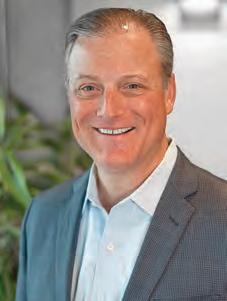
Uncertainty remains. Many tariffs were imposed under the International Emergency Economic Powers Act.
The U.S. Court of Appeals for the Federal Circuit ruled on Aug. 29 that while the IEEPA permits regulation, it does not authorize the president to impose wide-ranging tariffs. The court allowed the tariffs to remain in place pending the government’s appeal to the U.S. Supreme Court, which has agreed to take the case.
Tariffs can be beneficial. Targeted tariffs can protect and expand domestic industries. Semiconductors are a particularly good example because of the political and business risk of relying on foreign producers. These strategic tariffs are effective when American manufacturers have the ability to ramp up production.
Contrast this with tariffs on clothing. Widespread clothing manufacturing disappeared in the U.S. decades ago because its production is relatively labor intensive and low skill. Clothing can be produced far more economically in countries where labor costs are lower. Clothing manufacturing will not reshore, so these tariffs are a deadweight cost to the U.S. economy.
Companies are forced to develop customs strategies to mitigate tariff impacts—a complex, costly undertaking. Middle market companies, especially those without in-house trade compliance teams, are struggling to interpret tariff classifications and rules of origin.
Although the rapid changes in proposed tariffs may be a negotiating strategy, they leave businesses uncertain. We hear business leaders voicing
increasing frustration with the lack of clarity in U.S. trade policy. This makes long-term planning nearly impossible, thwarting the stated objective to induce large investments in new plants and equipment. Trust in the stability of U.S. trade policy has evaporated.
This uncertainty has extended to the broader economy. Reuters reported that merger and acquisition deals have slumped to a 20-year low following the Liberation Day declaration. The University of Michigan Consumer Sentiment Index has sunk to levels below its 2007 to 2009 recession lows. Consumers in that survey expect yearahead inflation rates of 4.8 percent. Ohio and Central Ohio are likely to fare particularly poorly. Imports and activity in the Columbus region’s distribution operations will likely slow. Increases in foreign tariffs on agricultural products are causing importers in those countries to shop elsewhere, threatening the viability of farms here and in other areas. The high tariffs on iron and steel benefit metal producers but harm metal users. Ohio has 112 firms producing iron and steel and employing 14,200 people. However, there are more than 7,200 firms that use metals in their production. These firms employ nearly 346,000. Production costs for these firms will rise, increasing the likelihood that demand for their goods will decrease.
Bill LaFayette, Ph.D., is the owner of Regionomics, a consultancy focused on regional economies and workforce strategy. Jeff Cope is managing director of JACO Advisory Group, helping mid-market and closely held companies overcome challenges and achieve growth.

BY CYNTHIA BENT FINDLAY
Koloma is exploring the potential of hydrogen from a new laboratory in the Innovation District at Ohio State University.
Tom Darrah, a co-founder of Koloma, a hydrogen exploration and extraction startup, likes to draw a parallel from his company to another fuel company also founded in Columbus: Standard Oil.
“I think of it as how Standard Oil was founded. We’re likely to explore in Ohio and around the world, as well as in the U.S., but the exploration engine will be here in Ohio,” says Darrah, the Ohio State University geologist whose research spawned what could become a global name in one of the 21st century’s most promising clean fuels.
Clean hydrogen doesn’t get a lot of attention compared with wind and solar. But hydrogen is already a critical industrial gas. It’s used to koloma.com

LOCATION: Energy Advancement and Innovation Center, 2281 Kenny Road, Columbus
LEADERSHIP: CEO Pete Johnson, Chief Technology Officer Tom Darrah
BUSINESS: Geologic hydrogen exploration and development
FOUNDED: 2021
EMPLOYEES: 50
FUNDING: $360 million in venture funding
make fertilizer, steel and fuels. Global hydrogen demand is rising and reached 97 million metric tons in 2023, according to the International Energy Agency. The gas also can be used to power fuel cells or be combusted, in which case the only emission is water vapor. Fuel cells can power anything from hearing aids to cargo ships and data centers.
Currently, the vast majority of hydrogen is refined from natural gas or other fossil fuels. A tiny amount—less than 1 million metric tons, according to the IEA—is produced from low-carbon emission methods such as solarpowered electrolysis.
A clean, low-cost source of hydrogen, Darrah says, could be revolutionary. Koloma believes it can kick off such a revolution.
Darrah, a geochemistry researcher for more than 20 years, says it’s long been known that natural hydrogen reservoirs were formed by subsurface reactions in rock, but no one believed they held economic potential.
He did. Darrah’s two decades of study to discern what catalyzes those reactions and where those conditions exist have led to a map of areas that could be tapped for extremely low carbon extraction of pure hydrogen.
Koloma was founded by Darrah, CEO Pete Johnson, former Chief Business Officer Paul Harraka and investors, including Breakthrough Energy Ventures (Bill Gates’ climate tech investment firm). Johnson says when he heard about Darrah’s research, he knew he wanted onboard.

“I’ve been in and around the hydrogen business for 15 years … but it’s always been a little too expensive and too far away. With geologic hydrogen, you can do things with this clean carbon-free tool no one thought you could do, and I wanted to be part of it.”
It’s feasible, Johnson says, to make carbon-neutral ammonia fertilizers, build plants to produce carbon-free steel that is less expensive than today’s materials, or produce cost-competitive, carbon-neutral synthetic diesel.
Koloma executives estimate the U.S. hydrogen industry could spark a 16 percent reduction in carbon dioxide emissions by 2050.
Their team includes members experienced in the world of petrochemical exploration and development. While Koloma is headquartered in Denver in order to take advantage of local extraction industry expertise, half of the company’s 50 employees work at the company’s new, 23,000-squarefoot lab in the Energy Advancement and Innovation Center in Ohio State’s Innovation District.
Additionally, Darrah is leading research at the lab on a process to mineralize carbon dioxide and stimulate hydrogen production from subsurface rock in a carbon-negative process.
Johnson says partners from around the world will be visiting the lab for years to come to access the analytical technology and tools being built there.
He says geologic hydrogen carries the highest risk but lowest cost potential of all clean hydrogen options. The company has raised more than $360 million from backers such as United Airlines, Amazon’s Climate Pledge Fund and other clean tech venture funds in the U.S. and abroad.

Sonya Thesing, executive
director
of the Hous Foundation, at Locker Soccer in Powell, where her organization holds events
From tackling homelessness to helping children find joy in activities, Sonya Thesing continues her advocacy work.
By SOPHIA VENEZIANO
+ Photo by TIM JOHNSON
As nonprofit leaders navigate burnout from emotionally draining work and leave the sector, Sonya Thesing has continued to advocate for children through another nonprofit leadership role.
After five years as the executive director of Huckleberry House, Thesing is now helping to lead the Hous Foundation, a nonprofit that provides $500 scholarships to enable children to participate in extracurricular activities. The program operates in Ohio and Maryland, where the nonprofit’s co-founders live. Gus Niewenhous and Kelly Cullum started the foundation after their sister and her two children lost their lives to domestic violence.
Launched in 2022, the Hous Foundation originally supported other nonprofit organizations before starting the scholarship program in 2024. Thesing joined the Westerville-based organization as its first executive director in January 2025 to help it expand the initiative.
Thesing says she loves being onboard at the beginning of a project to help it launch and grow. Her main goal has been increasing the number of children served. “We always say we want all kids to have access,” she says. “When we say all kids, that

means it shouldn’t be hard for them to apply and be funded.”
The Hous Foundation started in 2025 with a goal of serving 50 children. It had already hit that mark by Aug. 16. As of late September, the foundation’s board had approved its 98th scholarship request and had six open applications to review.
Beyond the fun of introducing kids to sports, music lessons or, in one case, a coding camp, Thesing says the organization’s work fills equity gaps. As she has gotten deeper into her new role, she says providing kids with opportunities they wouldn’t otherwise have is the best part of her job.
“They’re not being exposed to any of these activities and the lasting benefits that lead to future opportunities,” she explains. “It feels fun, and it feels good to be helping kids experience things, but I’m starting to really be driven by the equity we’re trying to create, too.”
In addition to her full-time nonprofit career posts, Thesing also served
on the board of the Human Service Chamber of Franklin County from 2022 through 2024. In this role, she was not always the loudest in the room but instead was the most caring, says Michael Corey, the chamber’s executive director. “She never approached her role by trying to speak for the young people she was serving,” Corey says.
Thesing says that being surrounded by a community that shows up to help others and, at its core, is filled with hope and optimism has lifted her through the challenges of the work.
“I can’t imagine living the last eight to 10 years not being surrounded by people who have such a role or perspective of service,” Thesing says.
This article was made possible by the Center for HumanKindness at The Columbus Foundation, which partners with Columbus CEO to showcase kindness in the community. Suggest ideas to Sophia Veneziano at sveneziano@dispatch.com. Learn more at ColumbusCEO.com/Kindness.





The December issue of Columbus Monthly will honor those who perform acts of kindness to strengthen, heal and unite our community.



Chosen by a panel of judges, finalists, semifinalists and “Dispatch Picks” will be honored at a December 3 event, where an overall Everyday Kindness Hero is announced. Vitria On The Square December 3, 2025 5:30 p.m. to 7:30 p.m.





















PHOTOS BY TIM JOHNSON
Columbus CEO honored the 82 winners of our 18th annual Best of Business reader poll on Oct. 8. The reception, held at Vitria on the Square in Columbus, drew about 220 guests for networking and an awards ceremony.
Thank you to our presenting sponsor, The Ohio State University Wexner Medical Center and The James; our platinum sponsors, Columbus Academy and Schneider Downs; and gold sponsor KEMBA Financial Credit Union.
We also thank our Best of Business event partners, Vitria on the Square, Queen Bee Jackie Creative and Mills James.
1 Brian and Alicia Ellis 2 Chelsey McClain and Karena Bailey 3 Jonathan McCombs, Alyncia Bowen and Patrick Bennett 4 Dr. Dukagjin Blakaj and Dr. Carlo Contreras 5 Serenity Duty and Laci Berkheimer 6 Maddie Audette, Kate Becker and Dee Anders 7 Joe Vandermark, Mike Voinovich, Kim James, David Brinkman, Kelly Murphy, Kiersten Roush and Carl Scharf 8 Hannah Namenyi, Emma Norris, Jylianne Matejovsky, Megan Vanderson, Erin Chorney and Aubrey Langley 9 Maria Miller, Adriana Matzke and Matt Thompson 10 Brent McCoy, Megan Sargent, Mike Montgomery, Brandy Duncan, Ayanna Bradley, Felecia Goins and Dawn Brahma

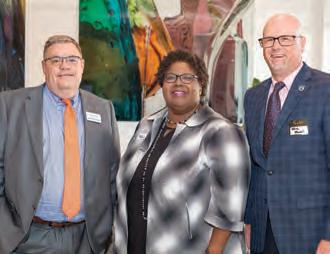


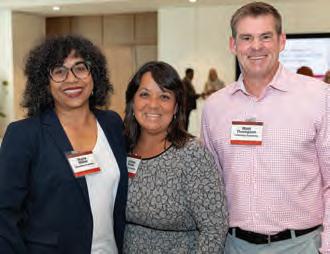

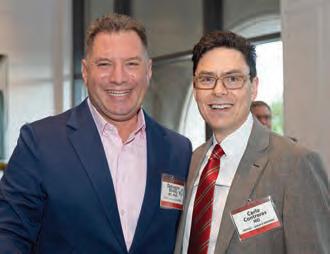



INNOVATION IN MOTION

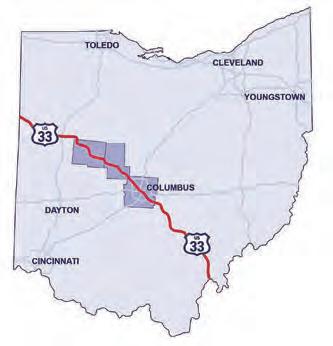


The Beta District was created because community leaders in Dublin, Marysville and Union County recognized that the future of mobility hinges on collaboration. Together, they transformed Central Ohio into a living laboratory where partnerships between public and private sectors drive innovation, test solutions and deliver results with global impact.

In The Beta District, collaboration is not abstract. Public and private leaders convene to test ideas, implement real solutions and foster an environment where innovation thrives. The inaugural Ohio’s Future of Mobility event in May 2025 showcased how these partnerships accelerate progress and spark new opportunities for investment, talent and growth.
World-class fiber infrastructure runs through the U.S. Route 33 corridor, providing unmatched connectivity and real-time data exchange for companies and organizations. This network is the
backbone of The Beta District, powering one of the most active hubs for mobility innovation in the country.
It enables companies like Honda, innovators like Memorial Health, research powerhouses like Transportation Research Center Inc. (TRC) and public sector partners like the Ohio Department of Transportation's DriveOhio and more to innovate, expand and prove what’s next.
The Beta District shows what happens when communities, industries and academia move in the same direction. For business leaders, it’s proof that collaboration fuels growth, attracts talent and strengthens regional competitiveness.
Central Ohio has long been a place where big ideas take shape. The Beta District is charting new ground, giving businesses and communities a place to test, invest and lead for the world to see.
Doug McCollough Executive Director, The Beta District
Columbus CEO
The Beta District: Innovation in Motion
GENERAL MANAGER
DISPATCH MAGAZINES
Katy Smith
EDITORIAL
EDITOR
Julanne Hohbach
CONTRIBUTING EDITORS
Linda Lee Baird, Lucy Clark
CONTRIBUTORS
Laura Newpoff
Peter Tonguette
DESIGN & PRODUCTION
PAGE DESIGNERS
Kathryn Biek, Kelly Hignite
PHOTOGRAPHY
PHOTO EDITOR
Tim Johnson
ADVERTISING
MULTIMEDIA SALES MANAGERS
Heather Kritter, Adam Trabitz
PRODUCTION DESIGNER
Rebecca Zimmer
MARKETING
MARKETING MANAGER
Lauren Reinhard
PRESS RELEASES
pressreleases@columbusceo.com
ADVERTISING
advertise@columbusceo.com
The Beta District: Innovation in Motion, a supplement to Columbus CEO, is published by Gannett. All contents of this magazine are copyrighted © Gannett Co., Inc. 2025, all rights reserved. Reproduction or use, without written permission, of editorial or graphic content in any manner is prohibited. Publisher assumes no responsibility for return of unsolicited materials.



Startups. Partners. Breakthroughs. This is where big ideas get tested, proven and put to work.


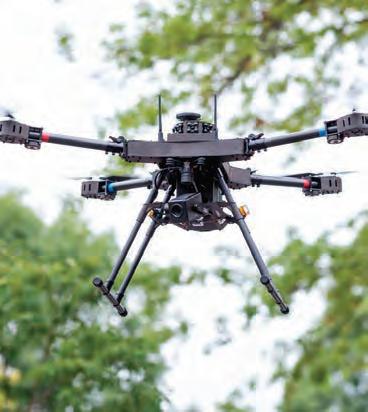
Take ParaWave, a startup whose Shepherd.AI system connects with any drone or aircraft. Police and firefighters get instant aerial awareness and the clarity to save lives.
ParaWave is headquartered at the Automotive & Mobility Innovation Center (AMIC), a center of collaboration for The Beta District. How can we launch your big idea?




The Beta District gives bold thinkers like ParaWave the space, talent and resources to move fast when every second counts.














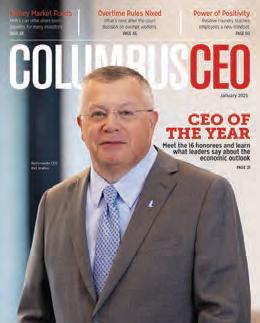

5 ABOUT THE BETA DISTRICT
6 MOVING SMARTER
The Beta District boasts a technologyenabled transportation network and 35 miles of fiber-optic broadband for businesses to conduct real-time research.
9 COLLABORATION AT SCALE: A REGIONAL MODEL
A council of governments oversight structure is reducing red tape and providing benefits for businesses along the U.S. Route 33 corridor.
11 WHY BUSINESSES CHOOSE THE BETA DISTRICT
Renowned test facilities, living labs and international connections are just a few of the assets companies find here.
14
CONVERSATIONS THAT MOVE THE FUTURE
Ohio’s Future of Mobility Conference drew an international audience to the 33 Smart Mobility Corridor.
Imagine a place where your business can pioneer and test new technologies not just in your own facility, but along a three-county corridor with assets including a robust fiber network, data centers, advanced highway infrastructure and a community of like-minded organizations.
You’ve found it in The Beta District.
The Beta District is an innovation corridor centered along U.S. Route 33, stretching from the city of Columbus in Franklin County into Union and Logan counties. While it is home to a variety of industries and organizations, including Honda, Cardinal Health, The Ohio State University, Ohio University, ScottsMiracle-Gro and others, it isn’t an ordinary economic development hub. Transportation is where the district truly shines.
Its centerpiece, the 33 Smart Mobility Corridor, boasts 35 miles of high-tech highway between Dublin and East Liberty where businesses can test autonomous and connected vehicle innovations safely and in real-world conditions. A 432-strand fiber-optic network connects a system of in-road sensors and roadside units so companies can collect live testing data. The fiber network also is available for Beta District based companies in other industries to utilize.
Though the district’s roots only stretch back to 2014, when local government leaders formed a group to study collaborative economic development, it already has attracted hundreds of millions of dollars in investment. But organizers believe The Beta District’s best days are yet to come.
Learn more at thebetadistrict.com.

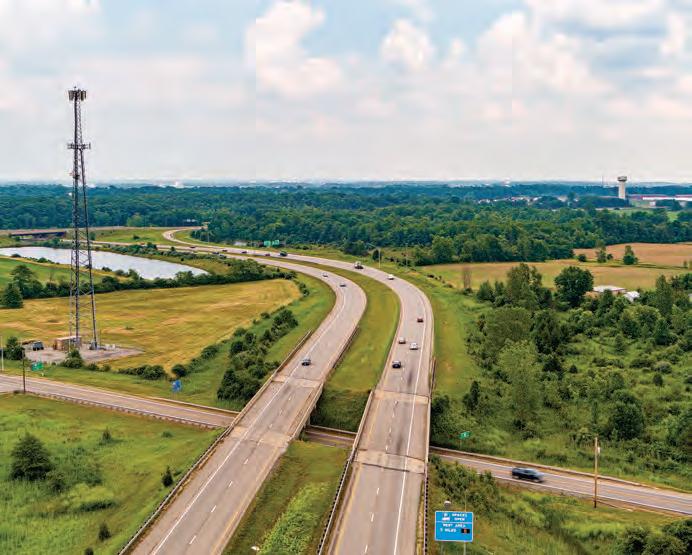

The Beta District boasts a technology-enabled transportation network and 35 miles of fiber-optic broadband for businesses to conduct real-time research.
By Peter Tonguette
If you want to know where automotive and aerial technology are headed, The Beta District offers a unique real-world preview of coming attractions.
The district’s fiber-enabled 33 Smart Mobility Corridor offers an ideal setting to test “smart,” or connected, innovations, as well as autonomous vehicles. The district is not only a home base for big players in the automotive industry, including Honda Development & Manufacturing of America and Transportation Research Center Inc. (TRC), but also to more than 70 other automotive companies and suppliers.
The corridor was expressly conceived as a testing space. “It’s one of the most advanced proving grounds for the testing of smart mobility from a perspective of connected vehicle technology,” says Eric Phillips, the Union CountyMarysville economic development director and CEO of the Union County Chamber of Commerce.
“It’s a proving grounds in an open setting with a number of automotive assets, around TRC [and] Honda, of course,” says Phillips, adding that the
wealth of human capital in the region makes it well suited to develop and study breakthroughs.
“We have 3,000 engineering jobs; we have 14,000 automotive jobs, all in the corridor,” he says. “And we also have over 6,300 life science positions, as well. There’s a lot of technology, a lot of advancement going on from that perspective.” Combined with the presence of Ohio State University’s Center for Automotive Research in Columbus, he says, The Beta District boasts “a lot of assets and human power in this area to make things happen.”
In many ways, the heritage of the district can be found in the formation of TRC in 1974. Automotive manufacturers and suppliers have long sought the expertise of TRC, based in East Liberty, as they scrutinize components in pursuit of greater safety and reliability.
“Before there was a Beta District, there was TRC,” says Brett Roubinek, the company’s president and CEO. “Way back in the ’60s, Governor Rhodes envisioned creating this place that would bring a focus to safety research and drive Ohio
economic development at the same time. Fast forward to today, and I believe that is the core of The Beta District.”
The beginnings of The Beta District date back to 2014, when government leaders along U.S. Route 33 formed a group focused on collaborative economic development and land use. This led to the establishment in 2016 of the NW 33 Innovation Corridor Council of Governments, which includes Dublin, Marysville, Union County and the MarysvilleUnion County Port Authority. The same year, the Ohio Department of Transportation committed $16 million to build a fiber-optic broadband network along the corridor. Another game-changing investment came from a $5.9 million U.S. Department of Transportation grant to fund dedicated short-range communications infrastructure to enable vehicle testing.
Those investments signaled to business “that we’re willing to invest actual dollars and actual infrastructure
to make a lot of these concepts reality as it improves safety and efficiency for the transportation system,” says Andrew Bremer, managing director of local affairs at DriveOhio, an ODOT initiative focused on smart mobility.
DriveOhio, which was created by executive order in 2018, fields inquiries from private sector businesses looking to make breakthroughs in transportation technology.
“Any time a company wants to come and be involved in The Beta District, it’s a partnership,” Bremer says. “The Beta District works with DriveOhio for allowing certain devices or concepts [in] The Beta District [or] on [the] U.S. 33 Smart Mobility Corridor. Those continued conversations with The Beta District and DriveOhio, as well as [a] particular company, result in improvements to particular products, or a technique, or a way of doing things.”
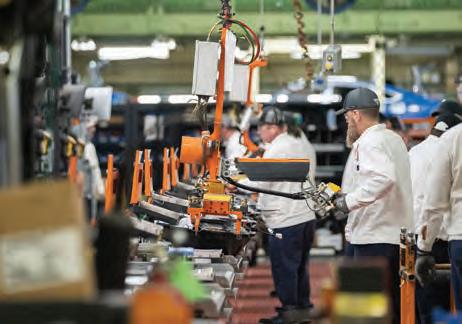
ADAS … assists the driver with vehicle operations such as acceleration and steering throughout the entire route, whether on expressways or surface roads, to the destination the driver inputs on the navigation system,” says Bob Nelson, executive vice president of American Honda Motor Co. “Developing next-generation ADAS is especially challenging in urban areas, where there are various types of people sharing the road, and where turning at intersections is frequent.”
The creation of the 432-strand, 35mile fiber network provided the “backbone” to support what became known in 2020 as The Beta District, Phillips says. “You … allow for future testing and become a hotbed for companies in this sector,” he says.
For example, by making use of the corridor, TRC can amass data relating to traffic, how vehicles react to different road situations and weather, and how such information can be relayed both to the driver and into the infrastructure. “What is really cool about the 33 Smart Corridor is it is essentially this extension of on-road testing that is equipped with different technologies,” says Taylor Manahan, executive director of services at TRC, who sees the corridor as a supplement to the company’s closed environment testing. “[A vehicle] can leave our front doors and head on this 33 Smart Corridor to continue their testing on the on-road portion to help holistically look at that verification and validation process.”
Today, The Beta District encompasses far more than the Smart Mobility
Corridor. “When we started this project, it was all about the 33 corridor only [and] testing the interstate light highway between TRC and the OSU campus,” Phillips says. “It evolved where Honda then came to us and said, ‘This is outstanding, we love this concept. … [But] we would like to have a possibility of testing in streets where we have buildings blocking views or buildings blocking radio waves.’ ”
Thus began Connected Marysville, an initiative that includes a network of more than 30 camera-equipped traffic signals that communicate real-time conditions to onboard units in motorists’ vehicles. “In Marysville, all of its signals are smart,” says Phillips. “Not only can [a camera] provide you a picture of what’s going on, [it] can also make determinations based upon what the camera actually sees. It can actually provide you intelligence … which is pretty remarkable.”
Also tested was emergency vehicle preemption, a system designed to alert drivers to the presence of nearby first responders that might be outside their line of sight. “You can actually get a warning in your car that would tell you, ‘Emergency vehicle detected in this area. Be on the watch.’ ” Phillips says. “That’s what Honda was testing.”
Officials from Honda point to multiple innovations that have been studied in the 33 Smart Mobility Corridor, including next-generation advanced driver assistance systems it plans to roll out on some electric and hybrid vehicles around 2027. “Honda’s next-generation
Safe Swarm, which enables wireless communication between vehicles to reduce traffic congestion and avoid collisions, also was researched on the corridor, Nelson says.
Connected Dublin has leaned into next-level mobility, too, with the deployment of smart traffic signals and intersections; the city is also testing smart technology on roundabouts.
Such success stories continue to draw companies to The Beta District to evaluate their own innovations. For example, Dutch company Technolution/TNL has tested traffic optimization in the district, Phillips says. “They tie all the [traffic] signals together to improve the flow of traffic to make certain all the signals are synchronized,” he says. “When you’re able to do it from a laptop in an office and control how traffic is flowing, [it] is different than just manually synchronizing streetlights to change as cars go through an area.”
DriveOhio joined forces with Bosch in utilizing cameras along the 33 Smart Mobility Corridor. “We use those cameras to detect wrong-way drivers, and we were able to partner with Bosch to make concerted improvements with those cameras and how they perform,” Bremer says. “Activities along The Beta District and the Smart Mobility Corridor do have the potential to live outside of that corridor and influence products that are used statewide.”
Much of The Beta District’s success has come on the ground, but the future
looks increasingly lofty as advanced air mobility is tested in the corridor.
“ODOT has been using drones for quite a while for our own operations to support ground infrastructure,” says Breanna Badanes, managing director of communications and policy at DriveOhio. “We can use drones for things like bridge inspections, survey work, even construction and traffic monitoring.”
Going forward, drones may revolutionize other areas, including health care. For example, drones could deliver medicines, medical equipment and, perhaps someday, blood and organs from one point to another, Badanes says. But testing comes first. “If something needs to be tweaked or adjusted from there to be able to scale it to a sustainable operation, we can start in communities like The Beta District to do that initial
implementation,” she says.
With defense technology company Anduril Industries set to open a billion-dollar hyperscale manufacturing facility in Central Ohio, a new wave of companies could soon arrive to take advantage of The Beta District—precisely the impetus behind a corridor designed to adapt to changing needs and uses. “[DriveOhio was] created by executive order … to remain flexible, to try and stay at the pace of this innovation, rather than some of the other states that are big in technology—say, California, for instance, that [have] to go back to their legislature any time some other development or an innovation happens,” Bremer says. That mission carries over into its work with The Beta District.
But mobility-focused businesses aren’t the only beneficiaries of the district’s numerous assets. Its fiber network
is being commercialized to benefit other industries. For example, Memorial Hospital in Marysville now utilizes the fiber system, which is tethered to a pair of data centers, to securely back up its information. “The Union County fiber loop … has been a great benefit to Memorial Hospital,” says Andy Chileski, chief information officer and vice president of diagnostic services for the hospital’s parent company, Memorial Health. “It provides us a secure, highspeed, redundant connection to the world-class data centers in Ohio.”
By any measure, The Beta District already has made Central Ohio a smarter, more connected region—in multiple ways. “There’s a lot of opportunities for companies that want to test,” Phillips says. “It’s tying that public and private sector together, and also [the] university. You have that triple helix.”

Smart traffic signals at the intersection of South Main and Sixth streets in Marysville
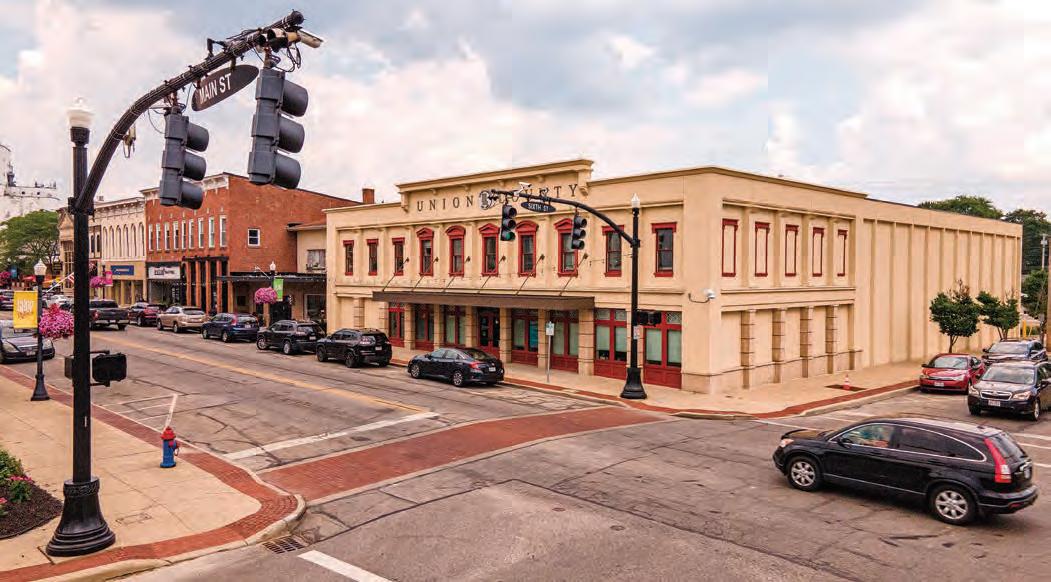
A council of governments oversight structure is reducing red tape and providing benefits for businesses along the U.S. Route 33 corridor.
By Laura Newpoff
The Northwest U.S. Route 33 corridor that stretches from Dublin to Marysville and through Union County is one of the most innovative ecosystems in the country. It hosts global brands such as Cardinal Health, ScottsMiracle-Gro and Honda Development & Manufacturing of America. More than 70 automotive companies call the region home, as do the nonprofit Transportation Research Center Inc. (TRC), Nestlé, OhioHealth, the Ohio State University, Ohio University and Columbus State Community College. Marysville’s 33 Innovation Park is home to the Automotive & Mobility Innovation Center (AMIC), a tech incubator operated by Lextant.
To leverage this powerful blend of industry and academia, a group of representatives from different community governments along the corridor began
meeting in 2014. Their discussions focused on how they could work together to help companies continue to innovate and drive economic development across their shared region. In 2016, they formed the NW 33 Innovation Corridor Council of Governments to oversee the creation of the fiber network and so that multiple agencies could collaborate to accelerate innovation and remove silos and red tape.
When the COG won the highly competitive $5.9 million grant from the U.S. Department of Transportation to outfit the region for connected vehicle testing, it was a watershed moment. That in turn fueled a series of developments and investments that have created a worldclass ecosystem of smart infrastructure and living labs.
In 2020, the COG, which includes
• Doug McCollough, Executive Director
• Terry Emery, Chair, NW 33 Innovation Corridor COG; Marysville City Manager
• Megan O’Callaghan, Vice Chair, NW 33 Innovation Corridor COG; Dublin City Manager
• Eric Phillips, Secretary, NW 33 Innovation Corridor COG; Executive Director, Union County-Marysville Economic Development Partnership; CEO, Union County Chamber of Commerce
• Bill Narducci, Member, NW 33 Innovation Corridor COG; Union County Administrator
• Keith Conroy, Member, NW 33 Innovation Corridor COG; Vice President, Hicks Partners
Dublin, Marysville, Union County and the Marysville-Union County Port Authority, formally branded this innovation hub as The Beta District. Doug McCollough, who was hired as the organization’s first executive director in July 2024, says the COG model continues to work well today.
“Three districts have come together to function as one innovation ecosystem,” he says.
“The Beta District provides a shared platform for pooling assets like the [35 mile] regional fiber loop, the transportation corridors and economic development resources, avoiding duplication and maximizing impact. Otherwise, these governments would be working separately as they had been doing for many years.

The COG provides a business-friendly model so companies don’t have to navigate separate government silos. This allows them to plug into the district as a whole.”
COG Vice Chair and Dublin City Manager Megan O’Callaghan says the COG was designed to be flexible and business friendly so private companies can engage with multiple public leaders through one entity to speed up deployment of their projects.
“A great example is instead of each community building its own isolated fiber network, we all share the regional fiber loop,” O’Callaghan says. “That means it is more cost effective, scalable and more attractive to businesses that now don’t have to deal with each individual community government separately.”
COG Chair and Marysville City Manager Terry Emery says the COG model “ensures that businesses can focus on innovation, supported by shared assets like the fiber infrastructure. That is really what ties The Beta District together.” This shared network allows organizations working on projects to be on the cutting edge of technology and move data with the speed and reliability that’s needed for vehicles and infrastructure to talk to one another in real time.
The Connected Dublin and Connected Marysville smart mobility projects rely on access to the fiber
network to collect data that is making street operations in these communities safer for residents.
Moving forward, McCollough’s goals include expanding the district’s Business Advisory Group to make sure more companies have a seat at the table to guide regional projects. He also plans to strengthen industry and research partnerships involving universities, Battelle and the Ohio Aerospace
Institute. Other goals include promoting the district on a national and global scale and engaging residents so they are aware of how projects benefit local communities.
“I’ll be working to raise the profile of The Beta District,” McCollough says, “so it’s known not only as an innovation zone but also a deployment zone where technology moves from the lab to the street.”
Business Advisory Board member Chris Berry, CEO and founder of Dublinbased automotive software and services company Echelle Resources, says McCollough has done “an outstanding job leading and elevating The Beta District in Ohio.”
“His vision and commitment to innovation have transformed the district into a hub for technology, mobility and community partnerships,” he says, “driving meaningful progress for our region.”
PUBLIC SECTOR/ GOVERNMENT
• City of Dublin
• City of Marysville
• DriveOhio (Ohio Department of Transportation)
• Logan County
• Mid-Ohio Regional Planning Commission
• Smart Columbus
• Union County
• U.S. Department of Transportation
PRIVATE SECTOR/ CORPORATE
• AECOM
• Accenture
• AGC
• Augustwenty Inc.
• Avaap
• Bosch
• Cisco
• DartPoints
• Deloitte
• Derq Inc.
• Ease Logistics
• Echelle Resources
• Expedient
• Forward Momentum
• Hicks Partners
• HNTB
• Honda Development & Manufacturing of America
• MH Corbin
• Michael Baker International
• MinebeaMitsumi Inc.
• Modular Assembly Innovations
• MurphyEpson
• NMB Technologies Corp.
• Oliver Wyman
• OmniAir
• P3Mobility
• ParaWave
• Parsons Corp.
• Perrone Robotics Inc.
• PNC Bank
• Solclusion Energy Group
• STV Inc.
• T-Mobile
• Taft Law
• Transform Labs
• Trihydro Corp.
• Verizon
• Vessel
• Visibility Marketing
• The Wendy’s Co.
• Woolpert
• WSP
ORGANIZATIONS
• One Columbus
• Rev1 Ventures
ACADEMIC/RESEARCH
• Battelle
• Lextant
• NREL (National Renewable Energy Laboratory)
• The Ohio State University
• Ohio University
• Parallax Advanced Research
• Transportation Research Center Inc. (TRC)

Renowned testing facilities, living labs and international connections are just a few of the assets companies find here.
By Laura Newpoff
Echelle Resources is an automotive software and services company that develops and validates the technology that powers next-generation automotive experiences and improves vehicle performance and reliability. The goal is to help manufacturers bring smarter vehicles to market with speed, precision and confidence—driving the evolution of mobility.
The company’s location in Dublin is an ideal place to serve its automotive industry customers. As part of The Beta District, it is in close proximity to major automotive manufacturing, the Automotive & Mobility Innovation Center (AMIC) in Marysville and more than 70 automotive companies that call the region home. It also has access to local colleges and universities, talent pipelines, municipal partners and
anchor companies that are open to co-development opportunities.
“It’s a strategic location that allows us to get to our customers and partners quickly,” says Echelle’s CEO and founder, Chris Berry. “Being able to get test cars so quickly and do proof of concept work on the drive back allows us to gather data quickly and take those findings back to our engineers, who can continue to innovate and pivot quickly if they need to.”
The company’s location also gives it a front-row seat to the living lab known as Connected Dublin, which is an ecosystem for businesses to pioneer new technologies, including smart mobility pilot projects. This includes the nation’s first connected roundabout, a smart parking lot and a network of technology-enabled traffic signals and intersections.
“These kind of real-world, sandbox environments are ideal for artificial intelligence, Internet of Things and audiovisual use cases,” Berry says. “It adds up to faster pilot projects, public-private collaboration and real-world test beds that shorten time to value. As we get more into the V2X [vehicle-to-everything technology] space, partnerships with municipalities like Dublin will allow us to see what kind of data they are collecting and then, perhaps, we’ll be able to implement that into our solutions.”
Another major draw to operating in the district is the 35-mile, 432-strand fiber collaborative along U.S. Route 33 and Industrial Parkway. This loop network allows automotive, R&D and manufacturing facilities to test smart transportation and autonomous
vehicle technologies on a highway that carries up to 50,000 vehicles per day. It instantaneously links researchers and traffic monitors with data generated from wireless roadside sensors, which provide traffic counts, weather and surface condition monitoring, and incident management improvements.
Businesses also can take advantage of the AMIC, which serves as a flexible platform for public-private innovation by connecting companies with a rich ecosystem of partners, test beds and workforce pipelines. Nearby in East Liberty, Transportation Research Center Inc. (TRC) is North America’s most advanced automotive proving ground, serving the world’s leading transportation companies.
Collaboration with international companies also is a draw to working in the district. Honda Development & Manufacturing of America is a major corporate anchor, and 60 Japanese companies have operations here, according to Eric Phillips, the Union County-Marysville economic development director and CEO of the Union County Chamber of Commerce. Other global companies such as Switzerlandbased Nestlé have facilities in the region, including a quality assurance
center in Dublin and an R&D product development center in Marysville.
“There are a lot of assets along the corridor, and the workforce is pretty top notch,” Phillips says.
“It’s a unique combination of assets,” says Doug McCollough, executive director of The Beta District.
“When you combine the cutting-edge infrastructure, the fiber loop, connected intersections, the AMIC and the TRC, the globally competitive workforce and the governance structure, it’s attractive to the business community. And it allows businesses to innovate faster with access to real-world conditions for real-world deployments, not just simulations.”
Another benefit, he says, is the opportunity to join the Business Advisory Group. “It’s a seat at the table with public leaders, global companies and peers in mobility, technology and advanced industries,” McCollough says. “You can position yourself next to the big engineering firms, auto manufacturers and consulting companies. It’s an opportunity to be a part of a community that will shape how innovation benefits not just businesses, but also residents and our region’s long-term growth.”
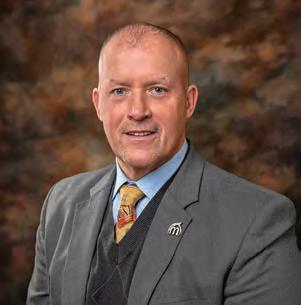
There are a lot of assets along the corridor, and the workforce is pretty top notch.”
Eric
Phillips, Union CountyMarysville economic development director





Lextant delivers clear insights for innovation strategy and design, giving you the foresight to lead your market, not just follow it. We help you see the future of your industry through the eyes of your customer, enabling you to build a roadmap and craft experiences for sustained market growth.














Located in Ohio’s fastest growing county and Marysville’s 33 Innovation Park, AMIC is where mobility leaders connect, collaborate, and grow.
From startups to industry giants, members gain access to training, networking, labs, and event space—all designed to accelerate innovation. Surrounded by more than 70 automotive companies along the US-33 corridor, AMIC offers the ideal launch point for testing and deploying the future of smart mobility.
To learn more, visit amicohio.org or growunioncountyohio.com .







Doug McCollough, executive director of The Beta District, speaks to attendees.
The Beta District’s inaugural Ohio’s Future of Mobility Conference brought together more than 150 attendees and over 90 organizations for a dynamic three-day exploration of mobility, innovation and collaboration along the 33 Smart Mobility Corridor and beyond.
Held May 13-15, 2025, at the Automotive & Mobility Innovation Center (AMIC) in Marysville, the event served as an international gathering point for those shaping the future of how we move, connect and grow.
With more than 50 expert speakers, immersive tours and insightful breakout sessions, the conference spotlighted the transformational work being done in The Beta District and the surrounding region.
The conference kicked off with a full day devoted to the power of cross-sector partnerships. Presenters included Robert Bell, co-founder of the Intelligent Community Forum; Paul Hoekstra, USA mobility business unit director at Technolution/TNL; and John Horack, Ph.D., professor and Neil Armstrong Chair in Aerospace Policy at the Ohio State University. Horack emphasized the convergence
of mobility innovation across land, air and space—and what that means for regional economies, community well-being and the next generation.
Conversations throughout the day made it clear that innovation doesn’t happen in silos: It requires aligned priorities, shared data and strong public-private ecosystems.
On day two, the focus shifted to showcase how ideas take root and come to life through mobility applications and workforce readiness. Highlights included breakthroughs in advanced air mobility, such as examining the potential of drones and eVTOL (electric vertical takeoff and landing) vehicles for cargo, transit and emergency services. Ground mobility innovations featured electric vehicle infrastructure, smart traffic systems and connected vehicles.
Jan van der Wel, founder of Netherlands-based Technolution/ TNL, provided a global perspective, highlighting how European mobility solutions can inform and inspire efforts in the United States. His insights reinforced the value of international collaboration and knowledge exchange.
The final day of the conference took participants out into The Beta District for tours at Honda’s Marysville Auto Plant and Transportation Research Center Inc. (TRC). These experiences brought to life the region’s unique capacity for real-world testing, validation and deployment of mobility technologies.
TRC’s SMARTCenter showcased why The Beta District is leading the way in connected and autonomous vehicle research. With more than 500 acres of closed track testing space, the center supports both public and private sector R&D, making it a cornerstone of the innovation ecosystem. The Honda tour illustrated why the company is a global leader and has been the catalyst for attracting 70-plus automotive suppliers to the area.
Ohio’s Future of Mobility Conference was a celebration of progress, a forum for fresh thinking and a launchpad for new ideas. From elected officials and engineers to researchers and entrepreneurs, participants’ insights sparked important conversations that will continue to shape the future of mobility, infrastructure and innovation in Ohio and beyond.


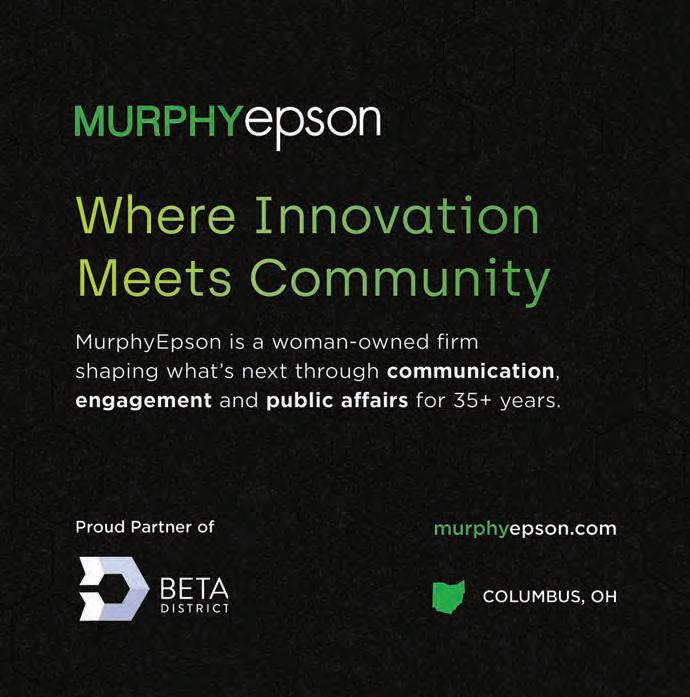



















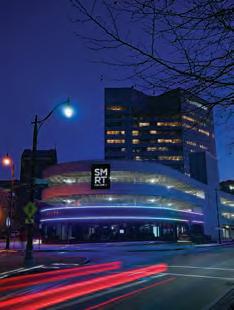











In an era when so much of banking feels automated and distant, community banks remain rooted in something simple: people. At Riverside Bank of Dublin, CEO Charles Moore sees that connection as the heart of what makes local banking matter. After years leading at large financial institutions, he returned to Dublin, drawn by something bigger than balance sheets—the chance to put relationships first.
Moore often says the success of a bank has very little to do with the name on the building but hinges on the people within the building. It’s a philosophy that stretches far beyond business. Just like a strong team makes the difference on the field, the right people shape financial success, too. Riverside Bank of Dublin offers that edge. They pair expertise with an understanding of the local landscape — meaning the guidance you get is grounded not only in markets but also in the everyday realities of the place you call home. Riverside has grown steadily over the past four years by leaning into those relationships and building trust, one conversation at a time. Accolades have included being named Ohio Bankers League Bank of the Year in 2024, receiving a Bauer 5 Star Rating, and recently being named to Columbus Business First’s Fast 50 in 2025.
Life doesn’t come in one-size-fits-all packages, and neither do financial needs. At other financial institutions,

approvals can feel like they’re handed down from faraway offices. Community banks work differently. Decisions are made close to home, by people who understand the context. That translates into quicker answers, more flexibility, and solutions that actually fit. It’s banking with nuance — and with neighbors.
Walk down any Main Street and you’ll see the impact of community banking. Small businesses rely on it not just for loans, but for partners who believe in their ideas. Across the country, community banks are among the largest lenders to small business, precisely because they’re willing to listen and customize. At
Riverside Bank of Dublin, that belief is in their DNA—it is why the bank was established. According to Moore “We understand Small Business because we are a growing business.”
Riverside Bank of Dublin invests in local entrepreneurs thus investing in the local economy — and in the shared future of the community.
A community bank’s story is inseparable from the story of its town. That’s why Riverside Bank of Dublin looks for ways to give back. This summer, the bank launched “Riverside Gives Back,” donating a portion of every new loan or account opening to the Dublin Food Pantry. It’s one example of how the bank’s success flows directly into support for schools, charities, and events across Central Ohio. Riverside’s management team is also involved in local organizations such as the Dublin Chamber and Ohio Police and Fire Pension Fund.
Community banking is more than a model—it’s a mindset. It’s about trust, relationships, and a belief that finance works best when it stays connected to people. For Moore and the team at Riverside Bank of Dublin, the goal isn’t just growth on a balance sheet; it’s helping the community grow right alongside them.
“Riverside Bank of Dublin is Different. We want to be different. We like to be different. We know you will drive by other banks to get to us, but we invite you to do just that and experience that difference.”

Jeremy Gutierrez Senior Commercial Banking Executive
Two Columbus-area developers discuss the local market, consumer demands, affordable housing and more.
If there’s one constant in the Columbus area, it’s change. The region continues to grow
and evolve—in both its population and its economy. Central Ohio continues to attract new business, while many companies located here thrive and expand.
This in turn helps keep the area’s commercial real estate developers busy. But it also presents challenges for the pace of growth and affordability.
We asked two of the developers who participated in our Leaderboard survey (see Page 41) for their thoughts on the local real estate market, how their businesses are evolving to meet consumer demands, the affordable housing crisis and challenges related to the region’s ongoing growth.
Here’s what they had to say.
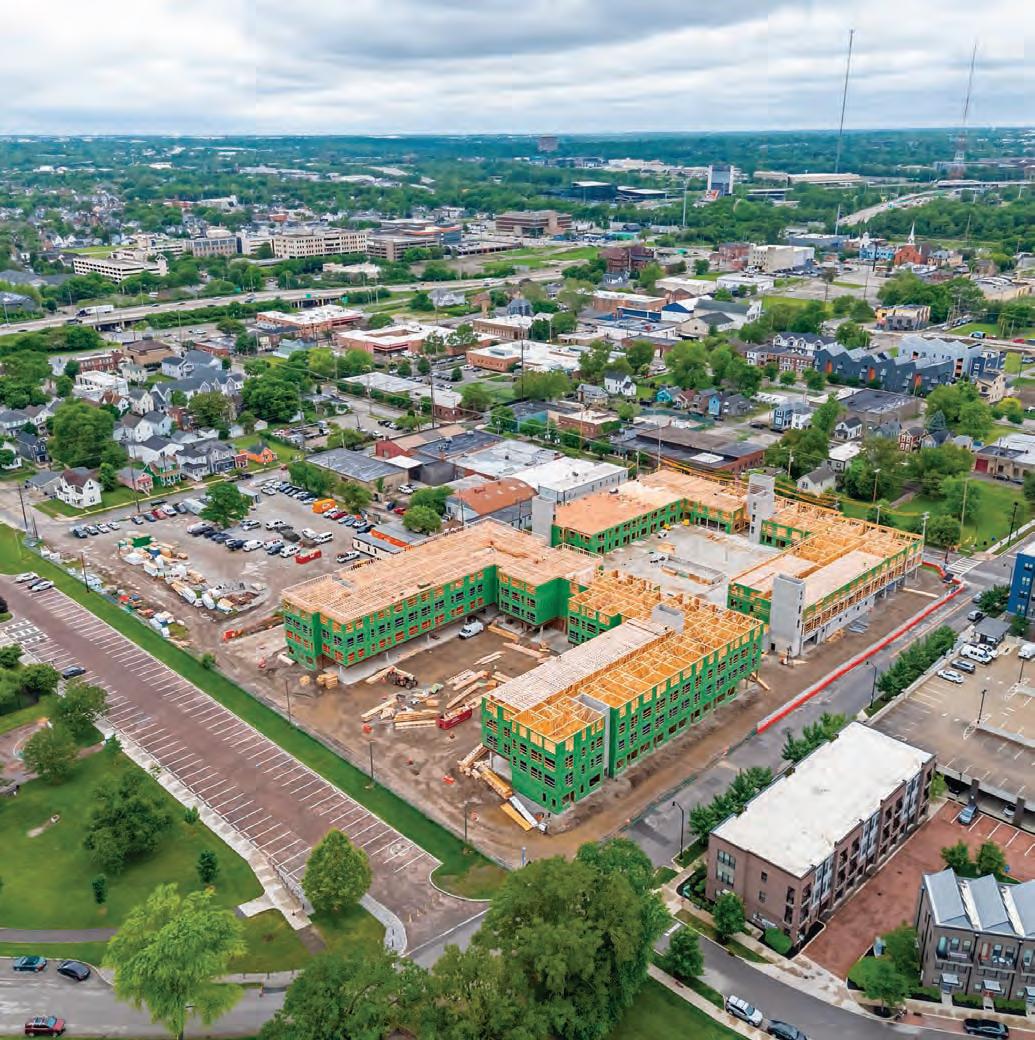
WestRich, CASTO’s $70 million mixed-use development in East Franklinton, will offer ground-level retail and 235 residential units.




BY ERIC LEIBOWITZ
WHAT MAKES THE COLUMBUS REGION STAND OUT FROM OTHER MARKETS WHERE CASTO WORKS?
Columbus stands out as one of the fastest-growing cities in the country, with steady, sustainable growth that continues to attract residents and businesses alike. The region’s diverse economy anchored by education, health care, technology and logistics has created a strong foundation for long-term stability. This balance allows the market to adapt and thrive through economic shifts, making it an exciting and resilient place to invest and develop.
YOUR COMPANY HAS DIVERSE OFFERINGS, INCLUDING MULTIUSE PROJECTS, COMMERCIAL AND RESIDENTIAL DEVELOPMENT, AND PROPERTY MANAGEMENT. WHAT HAVE BEEN THE BIGGEST GROWTH OPPORTUNITIES IN THE LAST FIVE YEARS?
Over the past several years, CASTO has personally seen tremendous growth in mixed-use development projects such as River & Rich, The Dexter, Graceland Flats, and more recently Thurber Village. These communities reflect a growing demand for walkable, connected environments where people can live, work, shop and dine within the same neighborhood. Residents and visitors are increasingly seeking convenience and lifestyle-driven amenities, and our portfolio has evolved to meet those expectations through thoughtful, community-focused design.
CASTO WAS A PIONEER IN THE DEVELOPMENT OF SHOPPING CENTERS. WHAT TYPE OF
ENVIRONMENT DO TODAY’S RETAILERS WANT TO PROVIDE FOR CUSTOMERS?
Today’s retailers are focused on offering more than just products for the consumer, they’re wanting to create experiences. Consumers want destinations where they can gather, dine and be entertained, not simply shop and leave. Our lifestyle centers reflect this shift, blending traditional retail with food, wellness and entertainment concepts to create vibrant spaces that encourage people to stay, engage and connect.
HOW CAN COMMERCIAL REAL ESTATE DEVELOPERS MAKE A POSITIVE IMPACT ON THE AFFORDABLE HOUSING CRISIS?
Commercial real estate developers can play a key role by collaborating closely with local municipalities and community stakeholders to create housing that meets a range of needs. By working within market conditions and leveraging available economic development tools, developers can deliver a balanced mix of housing options across different submarkets and demographic profiles. This approach not only addresses
affordability but also supports inclusive, sustainable growth within the communities we serve.
WHAT CHALLENGES DO DEVELOPERS FACE RELATED TO CENTRAL OHIO’S ONGOING GROWTH?
As Central Ohio continues to expand, developers face the challenge of aligning projects with long-term community goals rather
The Residences at Maren Reserve, Wilcox Communities’ first project in Plain City, opened this summer.
than focusing solely on short-term demand. Rising construction costs, tight development timelines and entitlement delays all add layers of complexity. Navigating these factors while ensuring that new projects contribute meaningfully to the region’s future growth and quality of life remains a top priority.
Eric Leibowitz is a partner with CASTO.
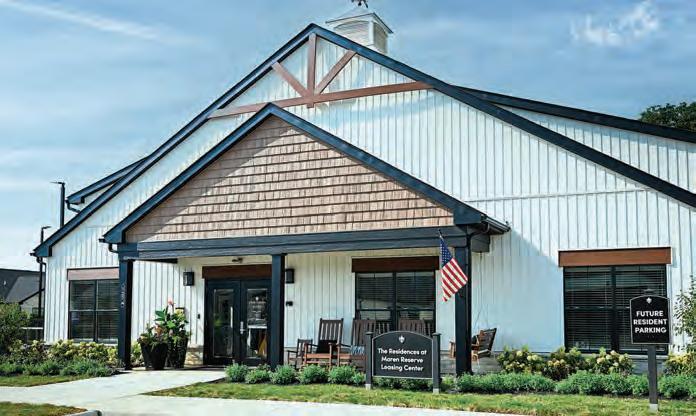



























BY JAMIE WILCOX AND JONATHAN WILCOX



WHAT SHIFTS HAS YOUR BUSINESS SEEN IN THE LOCAL REAL ESTATE MARKET IN THE LAST 20 YEARS?








The market has gotten more competitive over the last 20 years. Today, there is a huge and growing need for housing in Central Ohio and many factors that are limiting supply of new housing. However, the collaborative nature of doing business in Columbus has not changed. Scarcity and opportunity have brought out the best of the builder and developer community, as we have continued to work collaboratively to create opportunities together.
We are very proud of our many strong relationships and love the strengthening spirit of cooperation that exists here in Columbus. From the standpoint of our specific business, we have shifted from primarily being focused on building homes and condos for sale to creating larger-scale multiuse developments and apartment homes for rent.
HOW HAVE CONSUMER DEMANDS CHANGED OR EVOLVED?
Consumers, especially those we work with, have high expectations and they continue to rise. These expectations include quality-built housing with attractive designs and thoughtful layouts. People also want their homes to have an identity; they don’t want to live in cookie-cutter neighborhoods without individual character. In addition, they want top-notch customer service and opportunities to connect with other people through shared experiences in their communities. We pride ourselves on developing “one community at a time,” meaning we take time to think about all these factors individually in every community, instead of taking a onesize-fits-all approach.
DO YOU FORESEE WILCOX COMMUNITIES BRANCHING INTO OTHER AREAS OF DEVELOPMENT, OR EXPANDING OUTSIDE OHIO?
We are always trying to stay true to our core competencies while also keeping an eye forward to
both opportunities and changing consumer preferences. This is a constant balance. We don’t currently have plans to branch into other areas of development, but are consistently improving our homes and developments. This is constant, methodical evolution that keeps our homes and developments fresh. We are currently expanding our footprint to other areas of Ohio. Expanding outside of Ohio is a possibility in the future, but we don’t have any plans to do that right now.
HOW CAN COMMERCIAL REAL ESTATE DEVELOPERS MAKE A POSITIVE IMPACT ON THE AFFORDABLE HOUSING CRISIS?
We believe the best, and really only, way to address the affordable housing crisis is to build and develop more homes. This is very basic economics—supply and demand. When demand outpaces supply, the cost of any good, including housing, goes up. That is the situation we find ourselves in now. The real estate development community is interested in doing more. However, we are only part of the solution,



as we are constrained by many factors outside of our control. Local municipalities, utility districts, state government and local citizens all have to be working together to allow the development community to build more homes.
WHAT CHALLENGES OR OPPORTUNITIES DO YOU SEE ON THE HORIZON RELATED TO CENTRAL OHIO’S ONGOING GROWTH?
Central Ohio is doing a lot of things right. We have created a pro-business environment that has encouraged the growth of investment and jobs in the region. There are efforts underway, led by Mayor Ginther and the city of Columbus, to remove the barriers to new development and unlock the opportunity for more housing. Right now, we are at a crossroads of both opportunity and challenge. We believe that the spirit of publicprivate collaboration that has defined Central Ohio will continue, and we will rise to the occasion.
Jamie Wilcox and Jonathan Wilcox are managing partners of Wilcox Communities.






Park National Bank
50 N. Third St., Newark 43055 • 888-474-7275 parknationalbank.com
Fifth Third Bank
21 E. State St., Columbus 43215 • 614-744-5909 53.com
First Commonwealth Bank
110 River Bend Ave., Powell 43065 • 800-711-2265 fcbanking.com
Vinton County National Bank
112 W. Main St., McArthur 45651 • 800-542-5004 vcnbfamily.bank
Buckeye State Bank
9482 Wedgewood Blvd., Powell 43065 • 614-796-4747 joinbsb.com
The Fahey Banking Co.
127 N. Main St., Marion 43302 • 740-802-7563 faheybank.com
Civista Bank
6400 Perimeter Drive, Dublin 43016 • 614-210-2439 civista.bank
KeyBank
175 S. Third St., Columbus 43215 • 614-460-3490 keybank.com
Community Capital Development Corp.
5475 Rings Road, Suite 110, Dublin 43017 • 614-645-6171 ccdcorp.org
Source:
Office, retail, warehouse, industrial, health care
Permanent, construction, SBA 504 and 7(a), bridge
Apartment, industrial, health care, hotel
Construction, bridge, permanent, fixed rate, variable rate, letters of credit
Retail, apartment
Construction, permanent
Office, retail, warehouse, industrial, health care, 1-4 family rental
CRE, construction, SBA 504, lines of credit, equipment
Office, retail, apartment, industrial, health care
C&I, permanent, construction, SBA 504 and 7(a)
Retail, apartment, industrial, health care, hotel
Commercial real estate, business term, SBA, lines of credit, Fannie Mae, FHA/HUD Section 221
Retail, apartment, warehouse, industrial, health care
Permanent, construction, SBA 504 and 7(a)
Retail, apartment, warehouse, industrial, health care
Bridge loans, construction loans, lines of credit; off balance sheet loans available
Office, retail, industrial, health care
SBA 504 and SBA 7(a) Community Advantage
Brady Waltz, Columbus Market President
Erich Murray, Vice President, Commercial Real Estate Director
William Kuhar SVP and Senior Corporate Banker
Chris Coryea, Senior Vice President
Gary Kovach, Senior Commercial Real Estate Lender
John Robinson, Director of Capital Markets
Ken Wiseman, Senior Vice President Pete Schmitt, Senior Vice President Laura Frum, President
Donald R. Kenney & Cos.
470 Olde Worthington Road, Suite 101, Westerville 43082 • 614-540-2404 drk-realty.com
Arcadia Development
411 E. Town St., Columbus 43215 • 614-446-2545 arcadia-development.com
Wilcox Communities
7000 N. High St., Worthington 43085 • 614-273-3100 wilcoxcommunities.com
VanTrust Real Estate
955 Yard St., Suite 100, Columbus 43212 • 614-745-0610 vantrustrealestate.com
CASTO
250 Civic Center Drive, Suite 500, Columbus 43215 • 614-228-5331 castoinfo.com
Falco, Smith & Kelley Ltd
250 E. Broad St., Suite 1100, Columbus 43215 • 614-228-5775 falcosmithkelley.com
Tenby Partners
2 Miranova Place, Suite 910, Columbus 43215 • 614-706-6000 tenby.co
Hallmark Communities
150 E. Broad St., Suite 600, Columbus 43215 • 614-883-1046 hccliving.com
Spire Development Inc.
330 W. Spring St., Suite 430, Columbus 43215 • 614-350-0391 livespired.com
Dune Cos.
475 Metro Place S., Suite 450, Dublin 43017 • 614-973-7982 duneco.com
m=million
Source: Survey of commercial real estate developers
Carlton at Berkshire, Berkshire Township; Fairfield Park, Lancaster; The Residence at Golf Village, Powell; The Clarkson, Hudson Crossing and Winchester Reserve, Columbus
Arlington Gateway and Golden Bear, Upper Arlington; 1036 S. Front St., Brewery District
The Residences at Maren Reserve, Lucy Ridge, Sara Crossing, Ryan Creek and Eastwood
BJ’s Wholesale Club in Commercial Point; Sephora BTS in Avon, Indiana; freezer/ cooler build-to-suit in Knoxville, Tennessee Office,
Thurber Village Redevelopment (Lucky’s Market, CVS, Park Monroe), WestRich, Crescent Woods Retail, apartments
Beulah Place Apartments phase 2, The Strand Townhomes, The Shoppes at Beulah Retail, apartments, build-to-suit
Edwards Farms Innovation Center, Mill Run Innovation Center, New Albany Innovation Center Office, warehouse, industrial, build-to-suit
Stillwell at Jerome Village Apartments, other
Canal Crossing, a 42-unit workforce housing apartment community in Hebron; Rincon Manor in Tucson, Arizona
Fran Meyers, Owner; Tre’ Giller, CEO Scott Patton, Managing Partner
Jamie Wilcox, Jonathan Wilcox and Randy Wilcox Managing Partners
Phil Rasey Executive Vice President, Development Ryan Lidke Vice President, Development Services
Frank Benson III, Don M. Casto III, Partners
Patrick Kelley, President
Richard Schuen, CEO
Richard Kirk, CEO
Scott Harrold and Tom Grywalski Principals
Birchak, CFO
Information compiled by Nichole Frederick Information was provided by the listed companies and was not independently verified. Some companies did not return surveys.
The former director of the National Cancer Institute brings a track record of innovation and a passion for accessible care to her role leading the OSUCCC – James.
BY SAMANTHA HENDRICKSON
Dr. Kimryn Rathmell knows that when it comes to eliminating the pain and suffering of cancer, no man, or world-renowned medical institution, is an island.
In May, Rathmell started as the new CEO of the Ohio State University Comprehensive Cancer Center –Arthur G. James Cancer Hospital and Richard J. Solove Research Institute after a nationwide search, succeeding longtime interim CEO Dr. David Cohn.
In a mid-July interview with The Columbus Dispatch, the former director of the National Cancer Institute gushed over the “synergy” of science and practical medicine that can better inform how we treat and cure diseases. When these worlds intersect, research thrives and patient care gets better.
“I was a biology and chemistry major, and I did that intentionally … but back then, we didn’t have a biochemistry degree. But I felt like the chemistry could be really informative of the biology and it absolutely was,” Rathmell explains. “I’m a physician and a scientist.”
Straddling those worlds helps her use basic sciences to help cancer patients, she says.
That kind of collaboration, that no-man-is-an-island mentality, already exists at the OSUCCC –James, Rathmell notes. It’s just one of the many reasons she came to the Columbus-based institution, alongside its dedication to innovation,
Dr. Kimryn Rathmell has been CEO of the OSUCCC – James since May.

focus on cancer prevention (not just cancer treatment) and its engagement and coordination with its community.
Rathmell still wanted to pursue the “big mission” of eliminating death from cancer while continuing work “at the ground level” like seeing patients and training students.
“There are really not many positions where you can be, like, vision and that kind of leadership and also still be in touch on the ground,” Rathmell says. “This offered that.”
A LEGACY OF CANCER CARE INNOVATION
Former director for the NCI is only her most recent accolade. Rathmell
was born in Nebraska, raised in rural Iowa, and earned degrees in biology and chemistry at the University of Northern Iowa.
On top of that, she received her biophysics degree and went to medical school at Stanford University, along with an internship at the University of Chicago and residency with the University of Pennsylvania. She liked tackling hard problems, she says, and working with patients through the entirety of their care— two motivations that married her physician-scientist identity early on. Rathmell is considered one of the leading experts in cancer care and
by
research, known for having spearheaded the fundamental science of investigating kidney cancers. She has held professorships and leadership positions at the University of North Carolina Chapel Hill and Vanderbilt University, where she led numerous clinical and transitional trial programs and mentored hundreds of junior researchers.
Those mentees, she says, who are “now tackling the toughest problems in medicine” are what she’ll be proudest of when looking back on her career.
Rathmell’s research has resulted in more than 300 published and peer-reviewed journal articles, and she’s been a go-to resource for the National Institutes of Health for over a decade. Earlier this year, she received the American Cancer Society Medal of Honor, the organization’s highest
honor and just one of many awards medical organizations have given her.
In 2022, to gain more knowledge in the business side of health care, Rathmell got her master’s in health care management from Vanderbilt University’s Owen Graduate School of Management.
When she got the offer to head the NCI in 2023, she called it “thrilling” and she “couldn’t sleep for days.” In her two years as director, Rathmell ensured training and education stayed funded, and Cancer Care Networks that were hubs of clinical care and research collaboration stayed open.
Now at the OSUCCC – James, Rathmell hopes to keep building on the institution’s existing foundation.
Engaging with the community and their needs is a priority, not just
locally, but throughout Ohio’s 88 counties, Rathmell says. Her hope is to take the discoveries and specialists at the OSUCCC – James to every part of the state, rather than asking those who need care to come to Columbus to access them.
One example is with current mobile lung-cancer screening with telehealth follow-ups so the health system can reach those without transportation or those in more rural areas to try to catch cancer before it progresses.
Rathmell says she’s inspired to get creative in rural health care, having grown up in rural Iowa herself, and she was excited that the OSUCCC – James was already working on it. Clinical trials by mail and partnerships with local doctors and laboratories established in rural areas are methods that would eliminate existing barriers like long drives or a lack of

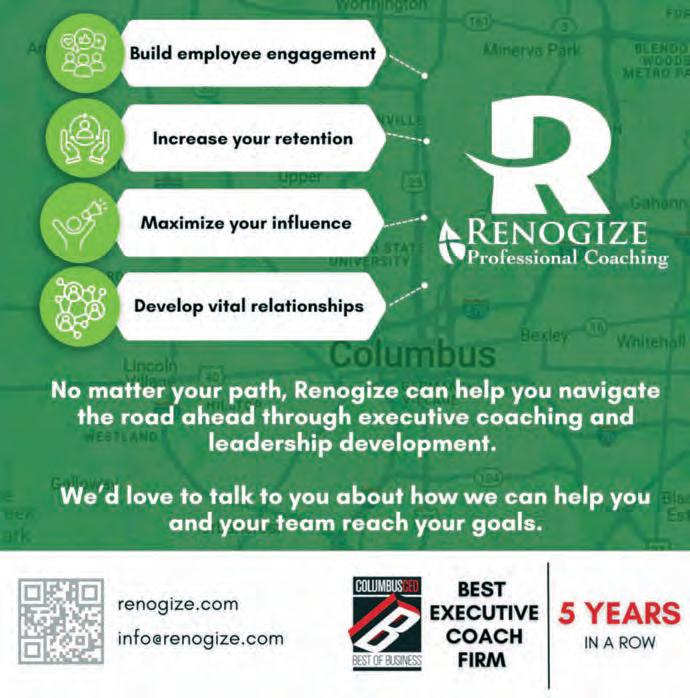

FedEx gets everywhere, so why can’t oncology get everywhere?”
Dr.
Kimryn Rathmell
transportation, she says.
“FedEx gets everywhere, so why can’t oncology get everywhere?”
Rathmell asks.
Rathmell’s appointment came just ahead of major disturbances to health care under President Donald Trump’s administration, including millions in federal funding cuts and a swath of changes to Medicaid.
The new CEO says she is watching federal changes closely in this new era of Medicaid. “It does keep me up at night,” she laments, recalling 20 years ago when she saw more frequent late-stage cancer diagnoses and less health care coverage.
“We really don’t want to get to where that’s somehow the norm again. I do think it’s important that we double down on prevention and early detection,” she says.
When it comes to overall health funding, the OSUCCC – James’ financial portfolio is one Rathmell can perhaps sleep on a little easier.
“One of the things that I was impressed by even when I visited here is how well balanced the portfolio is already. I think that will position us well,” she says, noting the institution’s funding through grants, philanthropy and clinical margins to support research.
“It’s prudent, anyway, and smart business to be looking at ways that we can take our discoveries and get them into commercialization … thinking about opportunities to partner in different ways with industry,” Rathmell says. “We’re thinking about a lot of different ways that we continue that support, because the mission is critical. It absolutely has to continue.”
Samantha Hendrickson is a reporter for The Columbus Dispatch.













TO OUR 2025 NATIONWIDE CHILDREN’S HOSPITAL
COLUMBUS MARATHON & 1/2 MARATHON SPONSORS!
PLATINUM SPONSORS



GOLD SPONSORS SILVER SPONSORS

CHILDREN’S CHAMPION TENT SPONSOR

PATRON SPONSORS





SUPPORTER SPONSOR ON COURSE SPONSORS
















PACE CAR SPONSOR

KIND DONORS














Columbus-area professionals say artificial intelligence can be a useful tool in the recruiting and hiring process, but there are pitfalls.
BY CHUCK NELSON
The potential of AI to bring greater efficiency and organization to human resources departments borders on the unimaginable.
“Artificial Intelligence is no longer just a tool in recruitment—it is the architect of a future where hiring could be fully automated, with massively more reach, and free from human bias,” a recent Forbes article opined. The shift could remake the process of hiring, onboarding and even mentoring, as well as accelerate decision making and optimize workforce planning “at a scale never before possible," Forbes predicted.
There’s no doubt AI has taken on a role in human resources and the hiring process. But Columbus-area HR professionals aren’t yet ready to embrace a hands-off stance and say the human element remains key.
Felicia Wilson, vice president of marketing for Dawson, is skeptical of claims about the sweeping impact of AI after her company’s nearly 60 years of helping clients with staffing needs in Central Ohio. “We use AI a little differently,” she says. Dawson selectively employs AI tools to help recruiters find more time to work with clients and applicants, she says.
“We like to personally respond to anyone who applies to us,” she says. “It’s our job to look beyond the résumé.”
Wilson says Dawson uses AI to track applicants in a database and automate communications to “dramatically reduce” the time recruiters spend on daily tasks. “AI does an

amazing job of matching skills and specific requirements and experience, but our recruiters understand and know our clients and the companies we work with.”
One thing AI can’t do is the culture match. We know how important it is to get that right.”
Felicia Wilson, vice president of marketing for Dawson
Despite AI’s innovations for various basic HR functions, it still has its limitations, Wilson says. “One thing AI can’t do is the culture match,” she says. “We know how important it is to get that right. We don’t want to send someone into an environment where they’re not going to thrive.
“AI’s not going away,” Wilson says. “We’ll continue to use it to add efficiency, but I don’t think it will ever replace the personal
relationships that we form.”
Chad Delligatti, CEO of Columbusbased staffing agency InnoSource, says AI is also making his recruiters more efficient.
“As we look at the AI engine, we are not getting rid of the recruiter’s touch, but we’re able to move more quickly,” he says, with the time needed to make offers cut in half.
InnoSource’s Minnie AI tool includes a recruiting engine, a knowledge base and an AI voice tool to automate some of the contact work that comes through the company’s service center clients. “We’re having amazing results so far implementing this in the HR field and into our workforce solutions,” he says.
Delligatti says the system allows the company to make offers to candidates more quickly and engage with them after-hours more frequently, which results in giving customers better hires. “At the end of the day, I think [AI] will enable us to grow quicker,” he says, but he also doesn’t see the technology taking over.
An $11 million investment from the Ohio High-Growth Investment Opportunities (O.H.I.O.) Fund will help the company continue to expand technology-based workforce
solutions with a focus in AI. “We went slow to go fast, making sure we really understood the industry,” Delligatti says. “We’re not changing who we are, we’re just adjusting.”
“I think when most people think about AI in HR, the first thing they think about is hiring,” says Joe Rotella, chief value officer for Delphia Consulting and a board member of the Human Resources Association of Central Ohio. “AI can scan a zillion résumés; it can surface skills that you’re looking for; it can cut down that whole time-to-hire process. That’s hugely important when the labor market is really tight.”
But he also sees an opportunity for companies to unlock potential by having AI analyze the data on a larger scale. “I think the real value comes after the people join” an organization, Rotella says. That’s the direction he hopes to take his company’s “miviva” AI tool (coined from the phrase “Mission, Vision, Values”).
The idea is “to unlock potential; to look at your entire employee base and see where people can grow; see where people or teams could be aligned better,” he says. “That’s what really drives performance.”
For example, AI could help set goals for individuals, guide one-on-one sessions between managers and staff, and provide feedback and tracking of goals inside and outside the company. “I’m trying to leverage all the data that an organization can have about its people, its strategic plan, its mission, its vision and have AI actually boost the organization, impact the bottom line,” Rotella says.
“I want to use AI to help create a culture of performance,” he says. “They can get feedback in the moment. They’re able to see how their work matters.”
However, like any technology, AI has its issues, Rotella says. One of the biggest has been removing bias from the process. “AI models, they were built by people, and people have biases,” he says. “You have to be careful about the biases.”
Cloud-based software company Workday is currently involved in a lawsuit to determine if its hiring system

As we look at the AI engine, we are not getting rid of the recruiter’s touch, but we’re able to move more quickly.”
Chad Delligatti, CEO of InnoSource
discriminates against job seekers based on race, age or disabilities. AI is “a super powerful tool that can help you get a lot done really fast or make a lot of big mistakes really fast,” Rotella says. “You have to start with some education and awareness.”
“It’s important for people to know that there’s currently no national law covering AI in the workplace,” says Heather Renee Adams, a labor and business attorney in the Columbus office of Roetzel & Andress.
The White House Office of Science and Technology Policy authored an “AI Bill of Rights” in 2022 as a framework for guidance, she says. The blueprint calls for protection from unsafe and ineffective systems; nondiscriminatory algorithmic systems; data privacy; a notice that AI systems were being used and an explanation of the system; and the ability to opt out and have access to a human alternative.
But implementing any of those concepts has been left to the individual states, she says. “That’s the thing about the law. The law changes slowly, but innovation and creativity does not,” Adams says.
“This is not the first time we’ve found ourselves out of step with some of the creative things that are going on in the tech world. But I do think it’s important that we pay close attention to it.”
Adams says that New Jersey law now makes employers responsible for AI-generated discrimination, “whether the employer created that tool or not.” Illinois law also holds employers liable for discrimination based on AI, she says. “So now we’re looking at situations where employers may not have actively or intentionally made a discriminatory decision but relied on AI, and the AI itself had some sort of biased data.
“Before you launch a system, you need to ensure that there has been an audit system put in place,” Adams says. “How do we ensure that the data out is really what we want? How do we identify those bugs that might result in a discriminatory decision, and how do you get it out of there? What responsibility do employers have to ensure that their AI systems are free of bugs before launching those systems?
“I think that employers are very cognizant of these things, and they’re trying to weed out as much as they can,” she says.
But the race to bring something to market first also factors in, and the pace of development continues to increase.
“It’s moving fast; very, very, very fast,” Rotella says. “It’s just amazing. It’s quantum leaps compared to 10 years ago. I don’t know where we’ll be in 10 years.”
Chuck Nelson is a freelance writer.
BY KATY SMITH

Several Central Ohio communities and school districts, especially in eastern Franklin and Delaware counties and Licking County, saw median home sales price growth topping 20 percent year over year in August, according to data from 2025 and 2024. Since 2010, the median home price across the Central Ohio Multiple Listing Service territory has more than doubled, growing by 152 percent from $134,000 in 2010 to $338,000 in August 2025.
Source: Columbus Realtors





Trade airport layovers for boardroom takeovers with daily nonstop flights to Los Angeles on American.